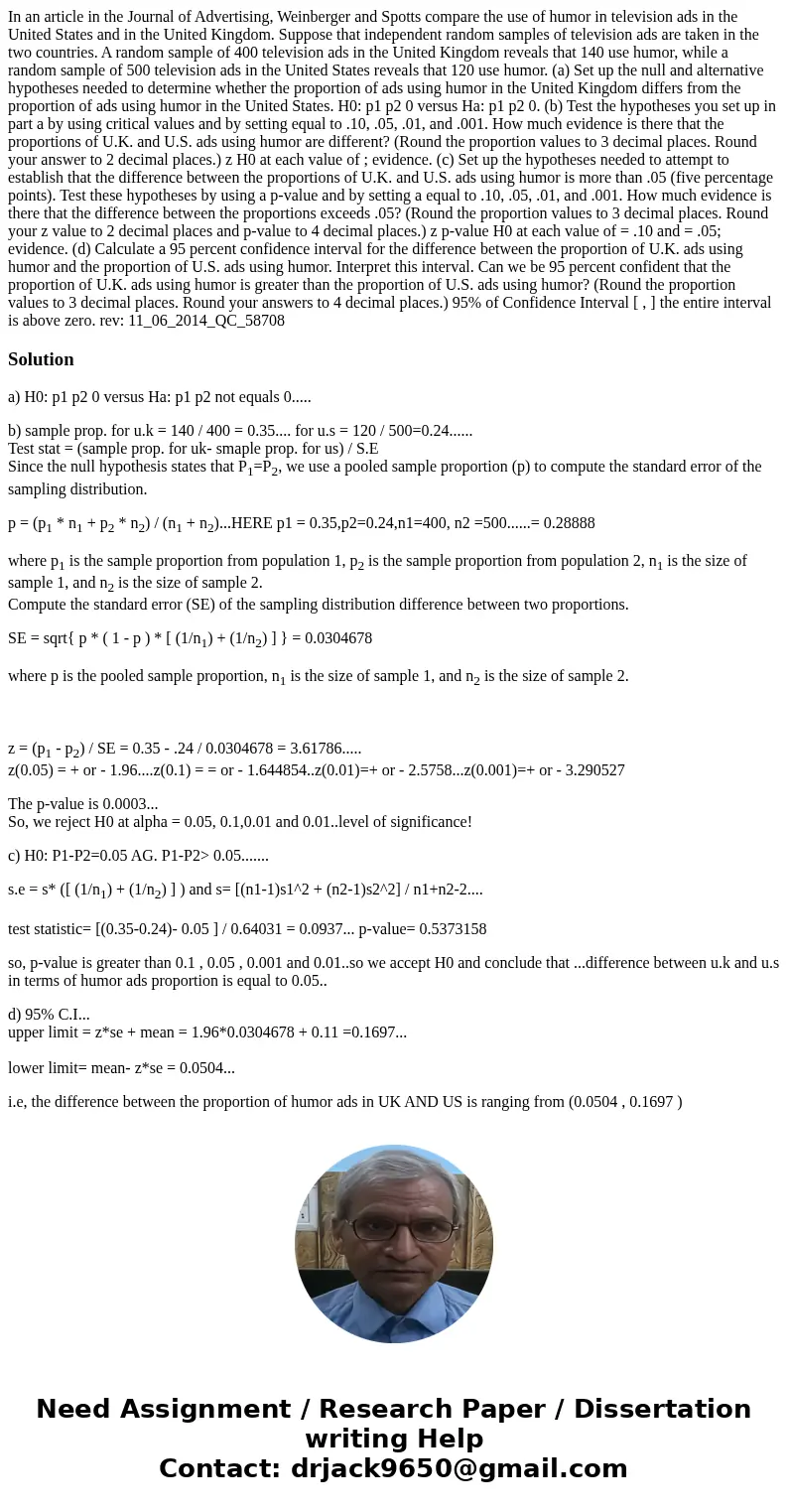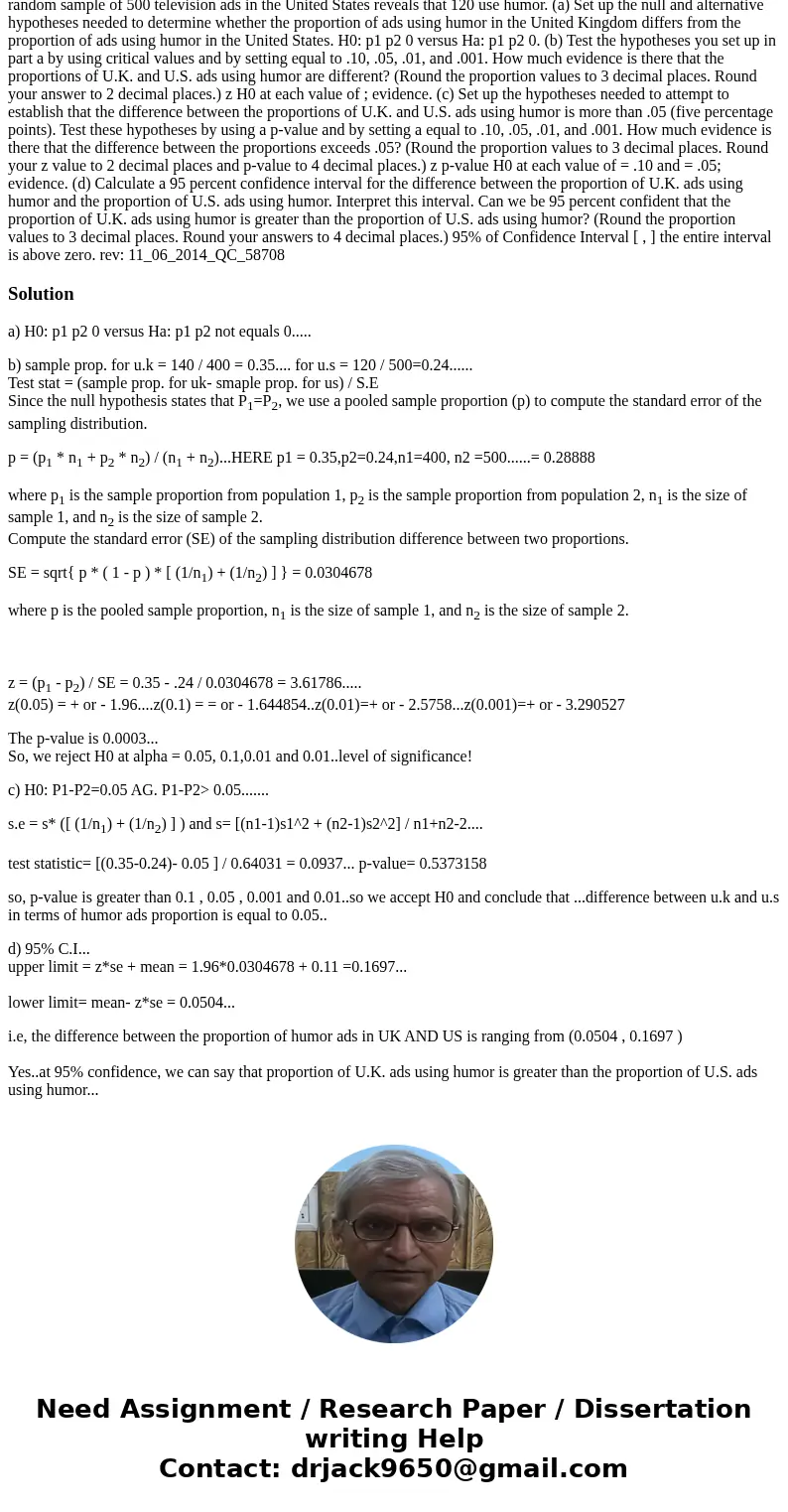In an article in the Journal of Advertising Weinberger and S
In an article in the Journal of Advertising, Weinberger and Spotts compare the use of humor in television ads in the United States and in the United Kingdom. Suppose that independent random samples of television ads are taken in the two countries. A random sample of 400 television ads in the United Kingdom reveals that 140 use humor, while a random sample of 500 television ads in the United States reveals that 120 use humor. (a) Set up the null and alternative hypotheses needed to determine whether the proportion of ads using humor in the United Kingdom differs from the proportion of ads using humor in the United States. H0: p1 p2 0 versus Ha: p1 p2 0. (b) Test the hypotheses you set up in part a by using critical values and by setting equal to .10, .05, .01, and .001. How much evidence is there that the proportions of U.K. and U.S. ads using humor are different? (Round the proportion values to 3 decimal places. Round your answer to 2 decimal places.) z H0 at each value of ; evidence. (c) Set up the hypotheses needed to attempt to establish that the difference between the proportions of U.K. and U.S. ads using humor is more than .05 (five percentage points). Test these hypotheses by using a p-value and by setting a equal to .10, .05, .01, and .001. How much evidence is there that the difference between the proportions exceeds .05? (Round the proportion values to 3 decimal places. Round your z value to 2 decimal places and p-value to 4 decimal places.) z p-value H0 at each value of = .10 and = .05; evidence. (d) Calculate a 95 percent confidence interval for the difference between the proportion of U.K. ads using humor and the proportion of U.S. ads using humor. Interpret this interval. Can we be 95 percent confident that the proportion of U.K. ads using humor is greater than the proportion of U.S. ads using humor? (Round the proportion values to 3 decimal places. Round your answers to 4 decimal places.) 95% of Confidence Interval [ , ] the entire interval is above zero. rev: 11_06_2014_QC_58708
Solution
a) H0: p1 p2 0 versus Ha: p1 p2 not equals 0.....
b) sample prop. for u.k = 140 / 400 = 0.35.... for u.s = 120 / 500=0.24......
Test stat = (sample prop. for uk- smaple prop. for us) / S.E
Since the null hypothesis states that P1=P2, we use a pooled sample proportion (p) to compute the standard error of the sampling distribution.
p = (p1 * n1 + p2 * n2) / (n1 + n2)...HERE p1 = 0.35,p2=0.24,n1=400, n2 =500......= 0.28888
where p1 is the sample proportion from population 1, p2 is the sample proportion from population 2, n1 is the size of sample 1, and n2 is the size of sample 2.
Compute the standard error (SE) of the sampling distribution difference between two proportions.
SE = sqrt{ p * ( 1 - p ) * [ (1/n1) + (1/n2) ] } = 0.0304678
where p is the pooled sample proportion, n1 is the size of sample 1, and n2 is the size of sample 2.
z = (p1 - p2) / SE = 0.35 - .24 / 0.0304678 = 3.61786.....
z(0.05) = + or - 1.96....z(0.1) = = or - 1.644854..z(0.01)=+ or - 2.5758...z(0.001)=+ or - 3.290527
The p-value is 0.0003...
So, we reject H0 at alpha = 0.05, 0.1,0.01 and 0.01..level of significance!
c) H0: P1-P2=0.05 AG. P1-P2> 0.05.......
s.e = s* ([ (1/n1) + (1/n2) ] ) and s= [(n1-1)s1^2 + (n2-1)s2^2] / n1+n2-2....
test statistic= [(0.35-0.24)- 0.05 ] / 0.64031 = 0.0937... p-value= 0.5373158
so, p-value is greater than 0.1 , 0.05 , 0.001 and 0.01..so we accept H0 and conclude that ...difference between u.k and u.s in terms of humor ads proportion is equal to 0.05..
d) 95% C.I...
upper limit = z*se + mean = 1.96*0.0304678 + 0.11 =0.1697...
lower limit= mean- z*se = 0.0504...
i.e, the difference between the proportion of humor ads in UK AND US is ranging from (0.0504 , 0.1697 )
Yes..at 95% confidence, we can say that proportion of U.K. ads using humor is greater than the proportion of U.S. ads using humor...


 Homework Sourse
Homework Sourse